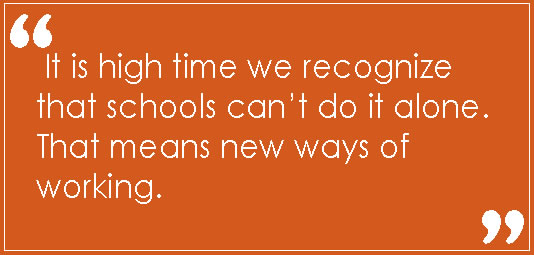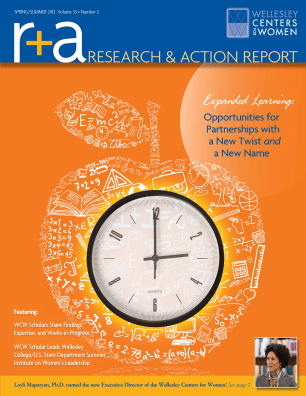Research & Action Report, Spring/Summer 2012
by Ellen Gannett, M.Ed.
The current debate on the virtues, definition, and efficacy of expanded learning opportunities (ELO) is familiar and welcome. With over 30 years in the field, I have watched the landscape of the out-of-school time field twist and turn by the decade and I am seeing earlier ideas presented in new terminology. Back in 1982, when the first director of the National Institute on Out-of-School Time (NIOST), Michelle Seligson and co-author, James Levine wrote the inaugural School Age Child Care: An Action Manual, their guiding premise was that “solutions are really to be found at the community level, and that they can best be developed by mobilizing people with similar interests to help one another.” The book emphasized a model of service delivery called “the partnership” between schools and other community groups and agencies. While it has taken decades to get here, there is promise in ELO if we can overcome previous barriers.
The partnership model of the ’70s and ’80s, was in many ways a necessity of survival for new non-profit community-based organizations (CBO) and a cornerstone of the way they did business. Yet, substantively, afterschool programs were rarely integrated into education policy and reform efforts. CBO providers fought hard to be considered part of the education system and needed to become skilled in overcoming numerous challenges for navigating relationships and turf 
issues with school personnel and administrations. Those that were successful provide valuable lessons for today’s partnerships.
With the No Child Left Behind Act and the huge expansion of the 21st Century Community Learning Centers (CCLC) program, many of these barriers were removed. The adoption of school-community partnerships was built into the legislation, giving way to a climate where partnerships are not only valued but required to achieve high quality programming. I wish I could say that the turf issues are now behind us, but for many providers, they still exist. The good news is that we are on the threshold of a new landscape. Now school and afterschool leaders are embracing partnerships with a renewed enthusiasm (and a new name) but with some new twists—expanded learning opportunities as a strategy to fully integrate schools and afterschool community-based organizations into a seamless day and year.
I believe the afterschool community can help shape the vision and the reality for ELO. And I believe the time is now. Rather than resist the changing landscape, afterschool providers ought to embrace the new ELO partnership movement bringing with them their rich history and expertise. For afterschool programs that have been accustomed to working independently, ELO presents opportunities for working together on planning, resource development, instruction, data sharing and professional development that can truly benefit children and their families. As stated in the Wallace Foundation report Re-imagining the School Day: More Time for Learning, “it is high time we recognize that schools can’t do it alone. That means new ways of working.”
It’s important, however, that we do not “throw out the baby with the bathwater” as the field evolves. Traditional afterschool programs, with their emphasis on youth development, must not be eliminated or de-funded as we try to figure out the next best ELO model. One size will not fit all and consequently we need a diverse delivery system. Most communities now recognize the positive influence 21st CCLC and afterschool programs have had on the development of their youth. We now have numerous studies indicating positive results of high quality programs. Young people who regularly attend have better grades and behavior in school and better relationships with their peers and adults. We’ve done great work. I’m pleased that so many leaders in the field are recognizing the importance of partnerships, and we should build off it.1,2,3
So what should schools and communities do during this period of transition? Here are a few ideas that I think would help promote strong school-community partnerships:
• Hire campus-wide out-of-school-time directors under the direction of the school principal. Often, these directors are current or former teachers or other school staff who can quickly build trust with school colleagues. The campus directors’ primary responsibilities would be to link services during the academic year with the afterschool and summer programs and to pay particular attention to children with special needs and at-risk youth who may need additional support services. The directors would be liaisons to classroom teachers, guidance counselors, parents or guardians, and community groups.
• Prioritize and strengthen summer programming. Recent studies have shown that summer learning loss is a significant problem. Strong summer programming provided by partnerships between schools and community-based organizations can help reduce learning loss, keep youth engaged in learning, and decrease the achievement gap (Cooper, Charlton, Valentine, & Muhlenbruck, 2000; Fairchild, Smink, & Stewart, 2009; McCombs, Augustine, Schwartz, 2011; McLaughlin & Pitcock, 2009).
• Consider blended staffing patterns during the academic year as well as the summer. Community-based programs can benefit from hiring part-time classroom teachers and other public school personnel—they can help bridge the academic needs of the students during afterschool hours and in the summer. This blended staffing approach will help to strengthen and align the school day curriculum with afterschool activities.
• Bring together in-school and out-of-school staff for professional development and peer support meetings. Many teachers and community program staff would benefit from training specifically on social-emotional and project-based learning in addition to formal opportunities to work together on curriculum planning.
• Promote accountability among partners. Principals and community organization leaders value written agreements outlining agreed-upon functions and tasks, including the sharing of child and youth data. Having a system-wide template that specifies goals, roles, and responsibilities would add clarity to the relationships among schools and community partners in hosting afterschool and summer programs.
• Create an out-of-school time advisory committee. The committee should include parents, directors of programs, school administrators, and other interested stakeholders. Its purpose is to advise in strategic planning and to give these interested parties a chance to have their voices heard.
By joining forces, classroom teachers and other school personnel working together with afterschool practitioners, cultural institutions, summer programs and other youth-serving entities provide young people the opportunities to experience a balanced curriculum during their learning day and summer. ELO need not be only about more time, but how we use that time and how well we use that time.
From my point of view, expanded learning takes partnerships to a new level and has the potential of blurring the boundaries between in-school and out-of-school time, taking advantage of many settings in the community, not just the school campus. ELO integrates the best of teaching and engages youth in active learning, positive youth development, and enrichment opportunities that will inspire them to be academically successful, good citizens, physically and emotionally healthy, artistic, social, problem solvers, and lifelong learners. What more do we want for our communities?
1 Vandell, D., Reisner, E., Pierce, K., Brown, B., Lee, D., Bolt, D., & Pechman, E. (2006). The study of promising after-school programs: Examination of longer term
outcomes after two years of program experiences. Madison, WI: University of Wisconsin—Madison.
2 Durlak, J., & Weissberg, R. (2007). The impact of after-school programs that promote personal and social skills. Chicago, IL: Collaborative for Academic, Social, and
Emotional Learning. In the Durlak and Weissberg study quality programs were identified as those that used evidence-based training approaches to promote personal
and social skills. These approaches to skill development are: sequential, active, focused, and explicit (SAFE).
3 Hall, G., Yohalem, N., Tolman, J., & Wilson, A. (2002). How afterschool programs can most effectively promote positive youth development as a support to academic
achievement. White Paper commissioned by the Boston After-School for All Partnership. Boston, MA: After-School for All Partnership. Also available from
www.wcwonline.org.


